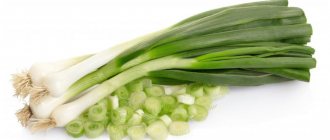OgorodGuruCom
Tips and tricks for gardeners
Popular
How to feed pepper and tomato seedlings with ash at home
Home › Vegetables › How to preserve the leek harvest in the apartment after digging it up from the garden
Leeks (or pearl onions) are a valuable vegetable of the Allium subfamily, a type of onion. Possible homeland is the Mediterranean coast. Leeks became most widespread in Western European countries, and the vegetable came to Russia only in 1961. Now in our country it is grown in all vegetable growing zones. This article will give comprehensive answers about leeks: when to harvest and how to store them correctly in order to preserve as much as possible everything valuable in them.
Description of leek
This biennial herbaceous plant has a striking external difference from its closest “relative”, the onion. It does not have a clearly defined bulb, and long, wide, dense leaves form a false stem. The “trunk” itself, depending on the variety, is 10-35 cm. The rest of the plant is gray, green or green-blue leaves. The height of the vegetable is 35-150 cm, width 2-8 cm, weight reaches 400 g.
Leeks have both a delicately sweet and restrainedly pungent taste (may vary), while their odor is moderate. This vegetable is rich in all kinds of beneficial substances. These include proteins, carotene, carbohydrates, iron, sulfur, magnesium, potassium, ascorbic and nicotinic acids, vitamins B and PP, thiamine, riboflavin.
Leek
Leeks are the only plant that “knows how” not only to preserve, but also to accumulate vitamin C during storage, increasing its volume by 1.5–2 times. The essential oils in its composition support the immune system and skin tone. Another advantage is low calorie content (only 35 kcal per 100 g of product).
Leeks have medicinal properties. It is used in the treatment of obesity and rheumatism. It normalizes the functioning of the gallbladder and liver. It has a diuretic effect and is recommended for physical, mental and even mental fatigue. Purifies the blood and normalizes hemoglobin levels. Effective in the fight against sclerosis. It is an excellent prevention of vitamin deficiency. Contraindicated only for diseases of the intestines and stomach.
Note! It should not be abused, especially in its fresh form, by those who have low blood sugar - the vegetable can aggravate the situation.
Ripening time
The ripening period is determined by whether the vegetable belongs to the group of early (mid-early), mid-ripening or mid-late (late-ripening) varieties.
Early and mid-early varieties (fast-growing)
The ripening time of these plants is 90-130 days, and harvesting occurs in the summer or early autumn. The varieties are used for preparing fresh dishes and processing. These include:
- Columbus. Bred by Dutch breeders. It is considered the best of the early ripening ones. An adult plant reaches 70-80 cm in height, while the white “leg” is up to 20 cm long, up to 6 cm wide, and weighs up to 400 grams. It is stored for a long time without losing either taste or commercial qualities. When grown, it does not require repeated hilling to whiten the productive part.
- Goliath. Very large variety. Here the “leg” of the plant is so dense that the “rings” are practically invisible, the leaves are bright and very juicy. The taste is very spicy. Bleached stems can reach 50 cm in height and 6-8 cm in diameter, weighing about 150-200 g. Characterized by rapid growth. Requires feeding due to low immunity to disease.
- Elephant's trunk. High-yielding variety. This is a plant with dark green leaves. Height 60-75 cm. The bleached part of the stem has a length of up to 30 cm, a diameter of 2.5-4 cm, and a weight of about 200 g.
- Vesta. A variety bred by domestic breeders. Has excellent immunity to diseases. Plant height 100-140 cm, width 2-3 cm, “leg” about 25-50 cm, weight 200-300 g.
Variety Columbus
Mid-season varieties
Their ripening period is about 150-160 days. Such varieties are suitable for winter storage and include:
- Winner. The plant has a medium height and green leaves with a grayish tint. The stem-leg also does not differ in particular length, maximum 20 cm, weight 200 grams. The culture has a soft juicy taste. More often it is used for home preservation.
- Casimir. A variety of German selection, very sensitive to lack of moisture, but at the same time it is very productive. The height of the white leg is 23-27 cm, the diameter of the trunk is 3-3.5 cm.
- Giraffe. The plant is tall - up to 140 cm. The leaves are frequent, forming a dense bush. Bleached part up to 30 cm, diameter 5-6 cm, weight up to 300 g. The variety has a weak pungent taste. High-yielding variety. Recommended for consumption both fresh or dried, and for canning.
- Tango. A variety that produces a bountiful harvest. The leaf is erect, dark blue-green in color. “Leg” up to 12 cm long, up to 5 cm in diameter. The taste is semi-sharp. Weight of one plant is 200-250 g. Frost-resistant. Recommended for both fresh use and long-term winter storage.
- Gulliver. A plant with bright green leaves reaches a height of 40-50 cm, has a “leg” 15-20 cm long and a diameter of 2-3 cm. The stem weight is 150-250 g.
- Kamus. Czech variety. A plant with green leaves of a concave shape, there is a waxy coating. The bleached part is approximately 20 cm long, diameter 2-2.5 cm, weight about 200 g. Frost-resistant.
- Bastion. The variety has medium length, gray or gray-green (gray-blue) raised leaves. The length of the bleached part is up to 30 cm, diameter 4.5-5 cm, weight up to 220 g. The variety is resistant to diseases.
- Jolant. The plant has narrow green leaves with a purple tint. The height is only 35-45 cm, the “leg” is up to 10 cm, the diameter is 2-2.5 cm and the weight is 150-200 g. The advantage of the variety is its high immunity to various fungi.
- Kilima. The plant is up to 1 m high. It forms a bleached stalk up to 25 cm long, 5 cm in diameter, weighing up to 150 g. It has a subtle semi-sharp taste. It is demanding of fertilizers, especially nitrogen, and is moisture-loving. Productive, cold-resistant, disease-resistant variety.
Variety Giraffe
Mid-late and late-ripening varieties
The ripening period for these crops is 180-220 days. They are highly resistant to harsh climatic conditions, especially frost. These include:
- Alligator. The plant is tall - up to 120-140 cm. The leaves are wide and flat. Thickened stem 30 cm long, 5 cm in diameter, weighing 300 g.
- Karantansky. One of the oldest varieties of leeks. The height of the plant is about 80 cm, while the bleached stem is about 25 cm in length and 6 cm in diameter. Average weight – 300 gr. High-yielding variety.
- Autumn giant. Dutch variety. It reaches a height of 120-130 cm, a large white “leg” can reach a length of up to 40 cm, a diameter of up to 8 cm. The weight of the plant is about 350-400 g. The giant requires repeated hilling, high-quality fertilizing, and plenty of moisture and light.
- Elephant (Elephant MS). Czech variety. Up to 150 cm in height, the bleached stem is about 30 cm in height and 4-5 cm in cross section. Weight 250-300 gr. Frost-resistant.
Important! To make the right choice of leek variety, you need to focus on the climate of the growing region.
More suitable varieties for regions are presented in the table:
How to keep green onions fresh in the refrigerator for a long time
Any dish will look more appetizing if it is sprinkled with herbs on top. I have already told you how to freeze dill, tomatoes, bell peppers and green peas for the winter. And green onions can also be frozen, and even after freezing they will look as beautiful in the finished dish as fresh ones.
To preserve green feathers for a long time, it is best to freeze them. To do this, the feathers must first be processed, their roots, wilted and dried tips removed, washed and dried on a towel. Well-dried feathers are cut into small (5-7 mm) rings, so that they can then be conveniently added to salads and soups.
The chopped feathers are transferred to dry containers and tightly closed with a lid. Greens have a specific smell, and to prevent other foods in the freezer from becoming saturated with this smell, the container should be sealed tightly.
Green feathers can also be frozen in plastic bags, having previously displaced all the air from it.
Frozen onions can be removed from the freezer at any time. Pre-dried onions do not freeze in one lump, so you can take the required amount and put the rest in the container back in the freezer.
If you want to keep green onions fresh for several days, after treating them to remove roots and wilted tips, place them in a jar of water. The water must be changed at least once a day. And it must be used in food no later than 5 days.
- Sprinkle with crushed chalk, it will absorb excess moisture. To do this, take 1-2 handfuls of chalk per 1 kg of vegetables.
- The lower part (bottom) is coated with clay and dried before storage, or burned with fire.
- Place a container of husks, chalk, sawdust in the room, that is, something that absorbs moisture well.
The first sign of rot will be flies flying in the room. This is a signal that the onions urgently need to be sorted out and rotten specimens removed.
Optimal storage conditions
Before answering the question of how to store leeks, you need to decide which part of the plant we are talking about: feathers or roots. The conditions that will need to be created to preserve the crop in good condition for a long time depend on this.
To preserve the feather, it is necessary to remove all damaged and dried parts of the vegetable. Then the greens are washed and dried in a dark place. Its long-term maintenance in optimal condition can be ensured in the following two ways:
- Finely chopped feathers are placed in bags and placed in the freezer.
- Well dried at a temperature of 50 ºC in the oven and ground greens are poured into a tightly closed paper bag or container. Used as a seasoning.
Preparing leeks for further storage
Tips and tricks
We offer useful recommendations for gardeners based on personal experience:
- The most unpretentious variety and tolerates wintering well in the soil is the Karantansky variety, proven over the years.
- On a farm in the Pskov region, the frost-resistant variety Bandit is grown by direct sowing of seeds into the ground at the end of July. Before winter it is earthed up, and already in June of next year it produces a harvest.
- In the southern regions, leeks collected from the garden are transferred to an empty greenhouse: they make a trench, lay the stems in it and cover it more than half with soil. This way it is stored until spring. In case of severe cold, the onion is additionally covered with thick cloth.
- If the winter is mild, during the thaw, several leek stems are dug up from the garden bed for food. It is enough to water the ground around it with hot water.
- Plants that have successfully overwintered in the spring are eaten before the leek shoots, otherwise the stem will become stiff.
Methods for storing leek root vegetables
Options for maintaining root crops in good condition are varied and depend on the available capabilities of the summer resident.
In the cellar
In the cellar, shelves are installed one above the other at a distance of 15-20 cm. Root vegetables are placed on them in one layer.
Important! Leeks should not be stored next to apples, as they cause rotting, and potatoes, as they quickly saturate the vegetable with moisture.
The cellar must be ventilated, which will ensure that there is no stagnation of air and eliminate the appearance of unpleasant odors.
When to Harvest
Like many other crops, leeks come in different varieties: some are grown for their feathers, others for their juicy heads. Green leaves can be collected all season, and the bulbs ripen on average 120 days after planting.
Important! At the last stage of ripening of the heads, approximately 2 weeks before harvesting, the planting is covered with agricultural material to preserve their snow-white color.
Harvesting time depends on the climate of the region in which the crop is grown:
- in the south - late July - early August;
- in temperate climates - mid and late August;
- in the northern regions (resistant early ripening hybrids are planted) - early September.
In any case, the crop must be harvested and prepared for storage before frost.
Weather conditions for collection
For harvesting, choose dry and sunny weather, which allows you to dry the fruits right in the garden. If you work after rain on wet soil, the bulbs can be damaged and then you can forget about long-term preservation of the crop. The damaged outer layer of the heads will begin to rot.
Signs of onion ripening
When leek feathers lie on the soil, and their tips and edges of the plates turn yellow, this is a sure sign of the ripeness of the vegetable.
It happens that the time for harvesting has already come, but the greens do not show any signs of ripeness. Then vegetable growers dig up the heads, cutting off the roots, which deprives the plant of nutrition and accelerates ripening.
Shelf life
| Storage method | Duration (month) |
| Cellar, basement | 6 |
| Sand | 6 |
| Bucket | 6 |
| Balcony | 6 |
| Freezer | 12 |
| Drying | 12 |
| Fridge | 2 |
Leeks are truly a wonderful vegetable, deservedly popular among the dacha community. To ensure the preservation of its valuable properties for a long time, experts have developed many successful varieties and recommended a dozen options for maintaining it in good condition for a long time. It will not be difficult for every gardener to choose the most suitable of them according to all parameters.











